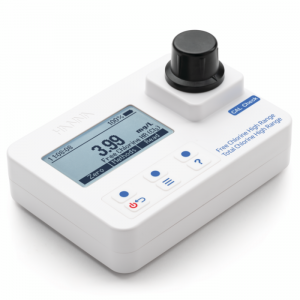
Environmental Monitoring of Nitrates and Other Water Quality Parameters: pH,
Environmental Monitoring of Nitrates and Other Water Quality Parameters: pH,...

Clean drinking water is essential to human urvival. To make sure the water we drink is free from harmful contaminants, water treatment facilities use different methods to purify it. One of the most common methods is chlorine treatment, particularly the use of free chlorine. In this article, we’ll discuss how free chlorine helps keep drinking water safe.
Chlorine is a potent disinfectant used to kill bacteria and viruses in drinking water. Free chlorine, also known as residual chlorine, is the amount of chlorine remaining in water after treatment.
Free chlorine plays a crucial role in drinking water treatment. Its primary function is to kill harmful pathogens like bacteria, viruses, and protozoa. When free chlorine is introduced to water, it interacts with contaminants, rendering them harmless and ensuring the water is safe to consume.
Free chlorine also prevents the growth of bacteria and viruses in the water distribution system. It has a residual effect, which means it continues to protect against contaminants even after being added to the water.
To ensure drinking water safety, maintaining the appropriate free chlorine levels is vital. The required amount of free chlorine varies depending on factors such as temperature, pH, and the presence of organic matter in the water.
Water treatment facilities measure free chlorine levels using methods such as test strips or chemical analysis. If the levels are too low, additional chlorine is added to ensure safe consumption.
In conclusion, free chlorine is a crucial component in ensuring drinking water safety. Its ability to kill pathogens and prevent the growth of bacteria and viruses makes it essential in water treatment. Therefore, maintaining appropriate free chlorine levels is necessary to guarantee safe drinking water.
There are several products available that can be used to test free chlorine levels in water. Here are some common options:
Colorimeters: Colorimeters are more accurate than test strips and can measure the exact concentration of free chlorine in water. They work by shining a light through a water sample and measuring the colour intensity. Hanna Instruments has a range of portable colorimeters and professional benchtop colorimeters designed to measure chlorine in body of waters.
Comparator Kits: Comparator kits are an inexpensive option that involves comparing the colour of a water sample to a standard colour chart to determine the free chlorine concentration.
Digital Testers: Digital testers use an electrode to measure the free chlorine levels in the water. They can be more expensive than other options but provide precise readings and are easy to use.
Test strips: Chlorine test strips are simple and affordable. You can dip a strip into a water sample, and the colour of the strip will change based on the level of free chlorine present.

It’s important to note that each testing product has its own instructions and limitations, so it’s crucial to follow the manufacturer’s instructions carefully to get accurate results. Additionally, you should consider the type of water being tested, the desired level of accuracy, and the frequency of testing before choosing a product to test free chlorine levels.
Environmental Monitoring of Nitrates and Other Water Quality Parameters: pH,...
Salt Concentration In A Brine Solution For Curing Salmon Traditionally,...

To empower customers to achieve quality by supplying intuitive, accurate, and reliable analytical instruments with exceptional customer service and value.
We take pride in every product we build. From an original idea to a completed product ready for testing. We oversee every aspect of the manufacturing process. It is this level of attention to detail that sets us apart.
To empower customers to achieve quality by supplying intuitive, accurate, and reliable analytical instruments with exceptional customer service and value.
We take pride in every product we build. From an original idea, to a completed product ready for testing. We oversee every aspect of the manufacturing process. It is this level of attention to detail that sets us apart.
To empower customers to achieve quality by supplying intuitive, accurate, and reliable analytical instruments with exceptional customer service and value.
We take pride in every product we build. From an original idea, to a completed product ready for testing. We oversee every aspect of the manufacturing process. It is this level of attention to detail that sets us apart.

